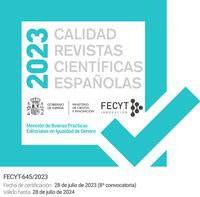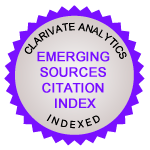Impacto político y políticas de memoria de la Cadena Báltica
DOI:
https://doi.org/10.14198/pasado.28873Palabras clave:
Cadena Báltica, Independencia, Mistificación, Resistencia pacífica, Autodeterminación, URSS, Política de la memoria, BasesResumen
La Cadena Báltica, un acto histórico de resistencia pacífica, desempeñó un papel crucial en los movimientos independentistas de Estonia, Letonia y Lituania. Este artículo examina su impacto en la disolución de la autoridad soviética en la región del Báltico y su evolución hasta convertirse en un poderoso símbolo de unidad y autodeterminación. Mediante un enfoque histórico cualitativo, el estudio destaca las experiencias compartidas de los Estados bálticos bajo el dominio soviético, el uso estratégico de movimientos no violentos y la repercusión global de la Cadena Báltica en la promoción de sus demandas de soberanía. La investigación explora el contexto sociopolítico del evento, la participación de las organizaciones de base y el papel crucial de la atención internacional. También aborda la mistificación de la Cadena Báltica a través de la política de la memoria y su perdurable influencia en los movimientos democráticos globales. Al tiempo que celebra su legado, el estudio reconoce las complejidades de los desafíos posteriores a la independencia, como las transiciones económicas y la integración de las minorías rusoparlantes. Al situar la Cadena Báltica en el marco más amplio de la resistencia pacífica, este artículo contribuye a comprender cómo la memoria colectiva y la acción simbólica pueden moldear la transformación política y las narrativas históricas. Además, destaca la interacción entre el activismo de base, la diplomacia internacional y la identidad cultural para forjar un movimiento cohesionado que trascendió las fronteras nacionales y sirvió de modelo para otras luchas por la autodeterminación y los derechos humanos en todo el mundo.
Citas
Atallah, Max, Ramiro Troitiño, David, & Kerikmäe, Tanel. (2018). El Colapso Del Regimen Comunista En Estonia (The Collapse of the Estonian Communist Regime). SSRN Electronic Journal. https://doi.org/10.2139/ssrn.3156924
Auer, Matthew Robert. (1998). Environmentalism and Estonia's independence movement. Nationalities Papers, 26(4), 659-676. https://doi.org/10.1080/00905999808408593
Bubnys, Arūnas. King, Matthew. & Kask, Ülle. (2016). The Baltic States: Auxiliaries and Waffen-SS soldiers from Estonia, Latvia, and Lithuania. In J. Böhler & R. Gerwarth (Eds.), The Waffen-SS: A European History (Oxford, 2016; online edn, Oxford Academic). https://doi.org/10.1093/acprof:oso/9780198790556.003.0005
Stephan, Maria Joan, & Chenoweth, Erica. (2008). Why Civil Resistance Works: The Strategic Logic of Nonviolent Conflict. International Security, Vol. 33, No. 1, pp. 7–44. https://doi.org/10.1162/isec.2008.33.1.7
Clemens, Walter Carl. (1991). Baltic Independence and Russian Empire. St. Martin's Press. https://doi.org/10.1007/978-1-349-12425-1
Davie, Grace Riestra Claire & Leustean, Lucian Nicolae (Eds.). (2021). The Oxford Handbook of Religion and Europe. Oxford University Press. https://doi.org/10.1093/oxfordhb/9780198834267.001.0001
Furmonavičius, Darius (2009). Sąjūdis's Peaceful Revolution, Part II. Lituanus, 55(2).
Galbreath, David & Galvin, Mary Elizabeth (2005). The Titularization of Latvian Secondary Schools: The Historical Legacy of Soviet Policy Implementation. Journal of Baltic Studies, 36(4), 449–466. https://doi.org/10.1080/01629770500000201
Kuldkepp, Mart. Piirimäe, Kaarel & Aunesluoma, Juhana (2022). Baltic crisis: Nordic and Baltic countries during the end stage of the Cold War. Scandinavian Journal of History, 47(3), 271–279. https://doi.org/10.1080/03468755.2022.2025896
Leffler, Melvyn Paul (2023). Human Agency and International History. Diplomatic History, 47(3), 526–528. https://doi.org/10.1093/dh/dhad003
Lieven, Peter Paul Anatol (1993). The Baltic Revolution: Estonia, Latvia, Lithuania, and the Path to Independence. Yale University Press.
Luts-Sootak, Marju & Siimets-Gross, Hesi (2020). Baltic peasants after emancipation – free and equal people or a new social estate in the estate-based society. In Legal Science: Functions, Significance and Future in Legal Systems II (pp. 162–164). Riga: University of Latvia. https://doi.org/10.22364/iscflul.7.2.12
Mälksoo, Lauri (2022). Chapter 2 The Legal Status of the Baltic States in International Law After 1991: Claims and Responses. In Illegal Annexation and State Continuity. Leiden, The Netherlands: Brill | Nijhoff. https://doi.org/10.1163/9789004464896_004
Mälksoo, Lauri (2023). The Baltic States. In A. van Aaken et al. (Eds.), The Oxford Handbook of International Law in Europe. Oxford University Press. https://doi.org/10.1093/oxfordhb/9780198865315.013.42
Misiunas, Romuald & Taagepera, Rein (1993). The Baltic States: Years of Dependence, 1940–1990. University of California Press.
Muižnieks, Nils (1987). The Daugavpils hydro station and “glasnost” in Latvia. Journal of Baltic Studies, 18(1), 63–70. https://doi.org/10.1080/01629778600000291
Norkus, Zenonas (2023). Baltic economic growth under foreign occupations and restored independence. In Post-Communist transformations in Baltic countries. Springer. https://doi.org/10.1007/978-3-031-39496-6_9
Plakans, Andrejs (2011). A Concise History of the Baltic States. Cambridge University Press. https://doi.org/10.1017/CBO9780511975370
Raun, Toivo (1991). The Re-establishment of Estonian Independence. Journal of Baltic Studies, 22(3), 251–258. https://doi.org/10.1080/01629779100000141
Rovny, Jan (2024). Major Minority: The Estonian Russians. In Ethnic Minorities, Political Competition, and Democracy: Circumstantial Liberals. https://doi.org/10.1093/9780198906742.001.0001
Saleniece, Irēna & Šķiņķe, Iveta (2018). Echoes of the Prague Spring in the Soviet Baltic Republics. In K. McDermott & M. Stibbe (Eds.), Eastern Europe in 1968. Palgrave Macmillan. https://doi.org/10.1007/978-3-319-77069-7_12
Senn, Alfred Erich (1991). Lithuania’s Path to Independence. Journal of Baltic Studies, 22(3), 245–250. https://doi.org/10.1080/01629779100000131
Smith, David James (2002). The Baltic States: Estonia, Latvia and Lithuania. Routledge.
Stranga, Aivars, Meškauskas, Kazimieras, Bater, James Hayter, & Misiunas, Romuald (2024, November 21). Lithuania. Encyclopedia Britannica. https://www.britannica.com/place/Lithuania
Tikhonravov, Evgeny (2023). The international community’s reaction to the soviet annexation of the Baltic Republics: The Recognition Dilemma. Netherlands International Law Review, 70, 251–272. https://doi.org/10.1007/s40802-023-00242-4
Troitiño, Ramiro David (2024). Estonia en el mundo de entreguerras: Los países de la nueva Europa y la Sociedad de Naciones: El caso de los países bálticos. Revista de Estudios Europeos, 84, 169–186. https://doi.org/10.24197/ree.84.2024.169-186
Troitiño, David Ramiro, Färber, Karoline, & Boiro, Anni (2017). Mitterrand and the great European design—From the Cold War to the European Union. Baltic Journal of European Studies, 7(2), 23–41. https://doi.org/10.1515/bjes-2017-0013
Troitiño, David Ramiro, Kerikmäe, Tanel, & Hamulak, Ondrej (2019). The League of Nations: Legal, political and social impact on Estonia. Slovak Journal of Political Sciences, 19(2), 75–93. https://doi.org/10.34135/sjps.190204
Vesilind, Priit P. (2008). Singing Revolution: How culture saved a nation. Tallinn: Varrak Publishers.
Vizulis, Joseph (1990). The Molotov-Ribbentrop Pact of 1939: The Baltic case. Praeger.
Weeks, Theodore (1994). Lithuanians, Poles, and the Russian imperial government at the turn of the century. Journal of Baltic Studies, 25(4), 289–304. https://doi.org/10.1080/01629779400000191
Ziemele, Ineta (2005). State Continuity and Nationality: The Baltic States and Russia: Past, Present and Future as Defined by International Law. https://doi.org/10.1163/9789047416203
Zvidrinš, Pēteris (1994). Changes of ethnic composition in the Baltic States. Nationalities Papers, 22(2), 365–377. https://doi.org/10.1080/00905999408408333
Descargas
Estadísticas
Publicado
Cómo citar
Número
Sección
Licencia
Derechos de autor 2025 Viktoria Mazur

Esta obra está bajo una licencia internacional Creative Commons Atribución-NoComercial-CompartirIgual 4.0.





